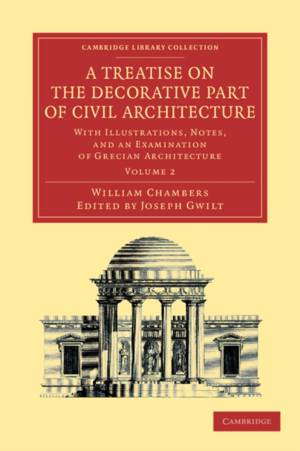
- Afhalen na 1 uur in een winkel met voorraad
- Gratis thuislevering in België vanaf € 30
- Ruim aanbod met 7 miljoen producten
- Afhalen na 1 uur in een winkel met voorraad
- Gratis thuislevering in België vanaf € 30
- Ruim aanbod met 7 miljoen producten
Zoeken
A Treatise on the Decorative Part of Civil Architecture
Volume 2: With Illustrations, Notes, and an Examination of Grecian Architecture
William Chambers
€ 83,95
+ 167 punten
Uitvoering
Omschrijving
Sir William Chambers (1722-96), architect and furniture designer, wished to further his career in the 1750s by publishing on architecture. He also became the Prince of Wales' architectural tutor, architect to the office of works, then head of the royal works (comptroller and surveyor-general from 1782). Notably, he remodelled Buckingham House (1762-73) and designed Somerset House (1775-96), but Chambers' reputation rests also on his Treatise on Civil Architecture (1759), which he revised and expanded in 1791 as A Treatise on the Decorative Part of Civil Architecture. It is regarded as one of the standard English texts on classical architecture, and remains essential reading. This reissue is of the two-volume edition of 1825, annotated by the architect and writer Joseph Gwilt (1784-1863). Volume 2 focuses on the application of the orders as well as smaller architectural features, including doors, windows, balustrades, chimney-pieces and ceilings.
Specificaties
Betrokkenen
- Auteur(s):
- Uitgeverij:
Inhoud
- Aantal bladzijden:
- 322
- Taal:
- Engels
- Reeks:
Eigenschappen
- Productcode (EAN):
- 9781108054706
- Verschijningsdatum:
- 23/08/2012
- Uitvoering:
- Paperback
- Formaat:
- Trade paperback (VS)
- Afmetingen:
- 152 mm x 229 mm
- Gewicht:
- 471 g

Alleen bij Standaard Boekhandel
+ 167 punten op je klantenkaart van Standaard Boekhandel
Beoordelingen
We publiceren alleen reviews die voldoen aan de voorwaarden voor reviews. Bekijk onze voorwaarden voor reviews.








